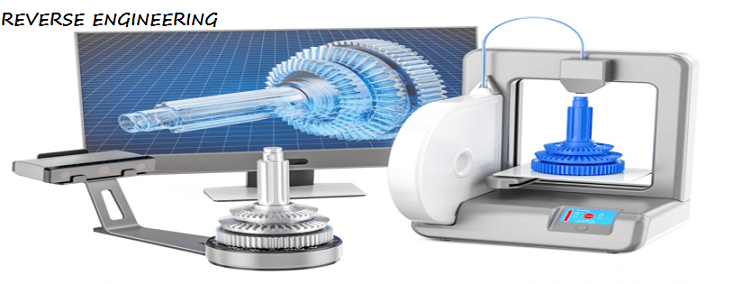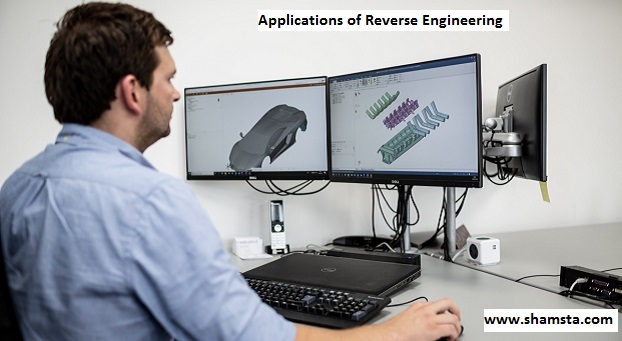
Reverse engineering is generally defined as a way to analyze an existing system and to design and create copies by identifying components and interrelationships. It is a process or method through which one attempts to understand through logic how a previously made device, process, system, or piece of software accomplishes a task with very little (if any) insight into exactly how it does so.
It is essentially the process of opening up or dissecting a system to see how it works, in order to duplicate or enhance it. Depending on the system under consideration and the technologies employed, the knowledge gained during reverse engineering can help with repurposing obsolete objects, doing security analysis, or learning how something works. It is also known as backward engineering.
Reverse engineering plays a vital role in the branch of mechanical design and manufacturing-based industry. This technique has been widely recognized as important in the product design cycle. In a regular computerized manufacturing environment, the operation order usually starts from the product design and ends with machine operation to convert raw material into a final product. It is often essential to reproducing a Computer-aided Design model of an existing part using any digitization techniques, when original drawings or documentation are not available and used for analysis and modifications are required to construct an improved product design.

In the reverse engineering approach the important steps involved, are characterizations of geometric models and related surface representations, segmentation and surface fitting of simple and free-form shapes, and creating accurate CAD models. The product re-design and research with reverse engineering will largely reduce the production period and costs in product manufacturing industries.
In the fields of mechanical engineering and industrial manufacturing, reverse engineering refers to the method of creating engineering design and documentation data from existing parts and their assemblies. While the conventional engineering process, transforms engineering concepts and models into real parts, in the reverse engineering approach real parts are transformed into engineering models and concepts. Reverse engineering has a very common broad range of areas such as mechanical engineering, software engineering, the animation/entertainment industry, microchips, chemicals, electronics, pharmaceutical products, etc.
The purpose of reverse engineering is to find out how an object or system works. There are a variety of reasons to do this. Reverse engineering can be used to learn how something works and to recreate the object or to create a similar object with added enhancements.it is also used to eliminate the disadvantages and increase the capabilities of existing products
Often the goal of reverse-engineering software or hardware is to find a way to create a similar product more inexpensively or because the original product is no longer available. Reverse engineering in information technology is also used to address compatibility issues and make the hardware or software work with other hardware, software or operating systems that it wasn't originally compatible with.Reverse engineering helps in obtaining the required product, advanced technologies, identifying the strengths and weaknesses of competitors and training engineering teams.

Reverse engineering is a multidisciplinary approach and virtually can be applied to the industrial field universally. The prime applications of reverse engineering are either to re-create a copy of part of the original part or retrace the events of what happened. It is widely used in software and information technology industries, from software code development to Internet network security. Thousands of parts are reinvented every year using reverse engineering to satisfy the aftermarket demands that are worth billions of dollars. The invention of digital technology has fundamentally revolutionized it. Compared to the aviation and automobile industries, the applications of digitalized reverse engineering in the life science and medical device industries have faced more challenges and advanced at a more moderate pace.

Research Engineering has been incorporated into the appropriate mechanical design and manufacturing engineering standards and multiple realistic product constraints with broad knowledge in multiple disciplines such as;
Applying knowledge of mathematics, engineering, and science in data analysis and interpretation.
Using techniques, instruments, and tools in reverse engineering applications.
Establishing systematic steps to help understand.
Identifying, formulating, and solving issues related to reverse engineering.
Understanding legal and ethical responsibilities pertinent to reverse engineering.
Assessing and evaluating documents and fostering attainment of objectives of a reverse engineering project.
Building technical capabilities and strengthening manufacturing technology through full knowledge and understanding of the product.
The possibility of designing a timely product, at the level of global standards, by discovering new ways to improve and develop the product, Also, satisfying the needs of the market, such as changing technology or improving it and reducing costs.
Training the required expert force in strategic industries.
The possibility of competitive modeling in order to understand competitors' products and better develop their own product
The possibility of re-engineering using the technical knowledge obtained by reverse engineering.
Exploring existing products: Backward engineering allows you to explore products that already exist. Evaluating the existing products in the market can result in innovation and discovery.
Recreating a product: One of the primary goals of reverse engineering is recreating a product without using a blueprint. Using this process, companies can make an old and outdated product, a less expensive version of a product, an obsolete machine part, and a competitor's product.
Repairing existing products: Companies can repair an existing product using this engineering technique. This can also help them identify common errors in a product's design and learn how to fix those for future projects.
Discovering product vulnerabilities: Companies can reverse engineer a new product or its prototype as a test. Through this, they can learn about the product in new ways and search for errors, inconsistencies, or overall vulnerabilities.
Inspiring innovation: Reverse engineering fosters innovation. It helps engineers connect projects with previous knowledge and develop innovative ideas.
Conducting failure analysis: You can use reverse engineering to analyze why a product did not work as intended. Examining a faulty product through backward engineering can help you identify its damaged parts and repair them.
Performing competitor analysis: An organization can reverse engineer a competitor's product to understand how it differs from other products in the market.
Reducing product development costs: By understanding how a competitor manufactures a product, a company can develop cheaper alternative solutions.
Reverse engineering helps us in obtaining the required product, obtaining advanced technologies, identifying the strengths and weaknesses of competitors, training engineering teams, and achieving engineering knowledge in cultivating direct engineering.
Reverse engineering has been widely used in many fields of science, including engineering design, industrial engineering, computer engineering, military field and automotive industry.
When a company has limited knowledge of an engineering part or when there is no two-dimensional (2D) or 3D model available, reverse engineering can provide design information. Companies like Shamsta use this technique when replacement parts from an original equipment manufacturer are obsolete or unavailable.
Shamsta uses reverse engineering to help optimize product assemblies and provides new and added features. They use reverse engineering principles to improve a product. Sometimes, they use this engineering technique for building digital archives to create a virtual environment for future reference.
SOFTWARE
Shamsta can reverse engineer a software program to understand more about it. They can create a new program based on the knowledge acquired from the reverse engineering process. They can also use this technique for software that requires improvement and maintenance. Though a computer program is not a tangible product, the reverse engineering process is similar. Shamsta programmers can extract the different parts and codes of a software program to understand its functionality and use.
Shamsta mechanics can reverse engineer different products, including washing machines, machine parts, vehicles, or air conditioning units. Without creating a new model, they disassemble a non-working part and find a viable solution. After finding a solution and fixing the malfunction, they can rebuild the product.
Shamsta engineers use the backward engineering concept to understand the design of a computer and its parts. They are able to deconstruct a computer to replace an existing part with a new part or run tests on a broken part. This is helpful for people who are new to building computers.
Reverse engineering is an essential tool for companies that perform network security assessments. In this process, shamsta divide its security team into parts. One team simulates attacks on software, while the other team monitors the network and reverse engineers the attack by other team members. The information from mock attacks can help strengthen the security of a corporate network.
In the construction industry, Shamsta architects use the backward engineering technique to solve problems of industries in the field of parts and machines . Using large scanners, the engineers or architects measure the 3D shape of the building or process plant. They can identify potential design flaws and fix them based on this information.we can localize a product at a lower cost and highest quality.
Shamsta uses reverse engineering tools such as disassembler and CAD to reads the binary code of a software product and display the executable instruction as text. They use a debugging program to prevent the disassembler from disassembling the program's data. Their engineers use this tool when the original blueprint of the product's design is unavailable.Consequently, If you want to do reverse engineering in your industry. Please don't hesitate to contact us, we will give the best offer by our Iranian experts